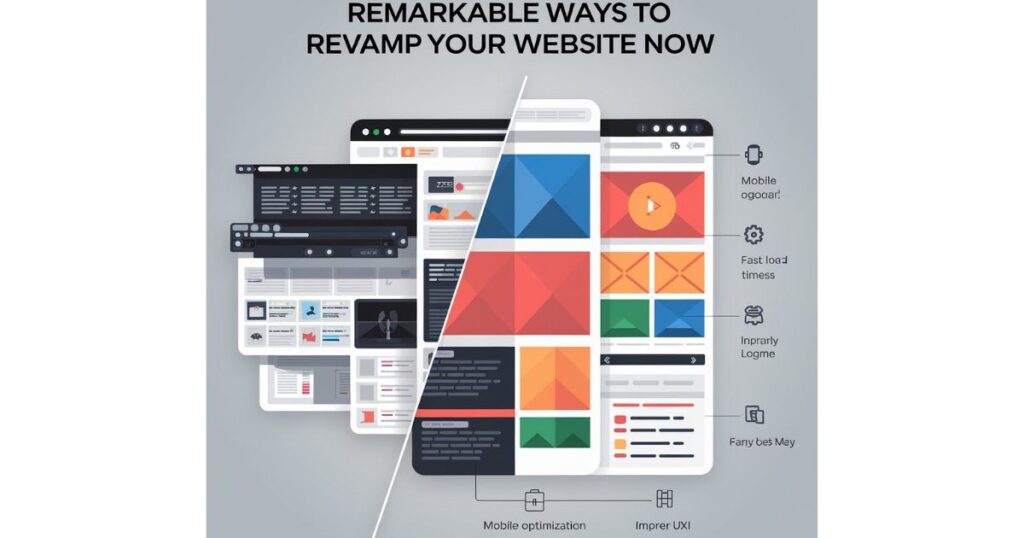Your website redesign strategies involves conducting thorough audits, setting clear goals, enhancing UI/UX, optimizing for search engines, implementing a robust content strategy, and continuous testing. Your focus should be on improving user experience, mobile optimization, and SEO to significantly improve your site’s performance and engagement.
Your website is often the first point of contact between your brand and potential customers. A staggering 94% of first impressions are design-related, making your website’s design crucial for success. This article will guide you through the latest strategies to revamp your website, ensuring it not only looks great but also performs exceptionally well.
1. Understanding the Importance of Website Redesign Strategies
User Experience (UX) In Website Redesign Strategies
A well-designed website significantly enhances user experience, leading to:
- Increased engagement
- Lower bounce rates
- Higher conversion rates
Brand Consistency In website Redesign strategies
Your website is a digital representation of your brand. Consistent design elements across all channels reinforce:
- Brand recognition
- Trust
- Customer loyalty
Search Engine Optimization (SEO) In Your Website Redesign Strategies
A redesign can dramatically improve your SEO by:
- Optimizing site speed
- Enhancing mobile responsiveness
- Improving content structure
2. Conducting a Thorough Audit In Your Website Redesign Strategies
Before diving into the redesign process, it’s crucial to understand your current position.
Website Analysis In your Website Redesign Strategies
Use tools like Google Analytics to gather insights on:
- Page load speeds
- User engagement metrics
- High-performing content
User Research and how it relates to website redesign strategies
Gather feedback from your users to understand:
- Pain points in the current design
- Features they find most useful
- Suggestions for improvement
Competitive Analysis and website redesign strategies
Analyze competitor websites to:
- Identify industry trends
- Discover best practices
- Find opportunities for differentiation
3. Defining Goals and Objectives in Website Redesign Strategies
Clear objectives are the foundation of a successful redesign.
| Goal | Example KPI |
|---|---|
| Improve user engagement | Reduce bounce rate by 15% |
| Increase conversions | Boost conversion rate by 10% |
| Enhance mobile experience | Increase mobile traffic by 20% |
Target Audience
Develop detailed user personas to inform your design decisions. Consider:
- Demographics
- Behaviors
- Preferences
- Pain points
4. Creating a Compelling User Interface (UI) When doing A Website Redesign Strategies
Design Principles
Adhere to essential design principles:
- Simplicity
- Clarity
- Consistency
Visual Elements
Utilize effective:
- Color schemes
- Typography
- Imagery
Mobile Optimization
Ensure responsive design for seamless experience across devices:
- Implement fluid grids
- Use flexible images
- Apply media queries
5. Enhancing User Experience (UX) When Doing Website Redesign Strategies
Create intuitive navigation structures:
- Use clear labels
- Implement a logical hierarchy
- Consider a sticky navigation bar for easy access
Content Organization and Website optimization tactics
Organize content effectively:
- Use headings and subheadings
- Implement white space effectively
- Use bullet points for easy scanning
Call to Action (CTA)
Design clear and compelling CTAs:
- Use contrasting colors
- Place CTAs strategically
- Use action-oriented text
6. Optimizing for Search Engines In Your Website Redesign In Website Redesign Strategies
Keyword Research
Identify relevant keywords:
- Use tools like Google Keyword Planner
- Consider long-tail keywords
- Analyze competitor keywords
On-page SEO Techniques
Implement on-page SEO best practices:
- Optimize meta tags
- Use header tags (H1, H2, H3) effectively
- Optimize images with alt text
Technical SEO
Address technical factors:
- Improve site speed
- Ensure mobile-friendliness
- Implement schema markup
7. Implementing a Content Strategy In Website Redesign

High-quality Content
Create valuable content that resonates with your audience:
- Address user pain points
- Provide actionable insights
- Use a variety of content formats (text, images, videos)
Content Marketing
Leverage content marketing strategies:
- Develop a content calendar
- Promote content through social media
- Implement email marketing campaigns
Content Management System (CMS)
Choose a CMS that aligns with your needs:
- Consider ease of use
- Look for SEO-friendly features
- Ensure scalability
8. Testing and Launch Your Website Redesign

User Testing
Conduct thorough user testing:
- Use A/B testing for different design elements
- Gather feedback through usability testing
- Implement changes based on user insights
Launch Strategy
Plan a detailed launch strategy:
- Create a launch timeline
- Prepare marketing materials
- Plan for potential issues and have contingencies
Ongoing Monitoring and Optimization
Implement continuous improvement:
- Regularly analyze performance metrics
- Gather ongoing user feedback
- Stay updated on industry trends and best practices
Emerging Trends in Website Design
As you revamp your website, consider these emerging trends:
- AI-driven Personalization: Implement AI algorithms to provide personalized content and product recommendations.
- Enhanced Accessibility: Design with accessibility in mind, ensuring your site is usable by people with various disabilities.
- Voice User Interface (VUI): Optimize for voice search and consider implementing voice navigation options.
- Micro-interactions: Add small, engaging animations to improve user experience and provide visual feedback.
- Dark Mode: Offer a dark mode option to reduce eye strain and appeal to user preferences.
By implementing these strategies and staying aware of emerging trends, you can create a website that not only looks great but also performs exceptionally well in today’s competitive digital landscape.
Remember, a website redesign is an ongoing process. Continuously gather feedback, analyze performance, and make iterative improvements to ensure your website remains effective and engaging for your audience. Read up on these tips for user centric design tips for your website.

